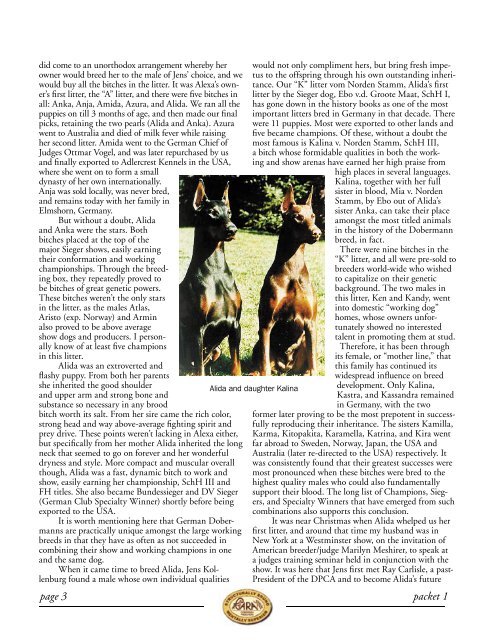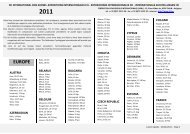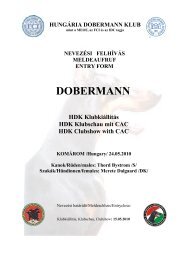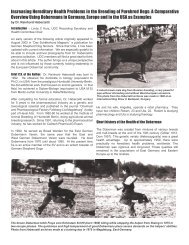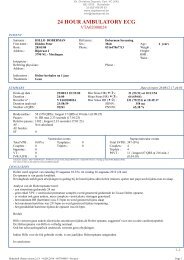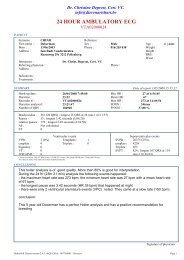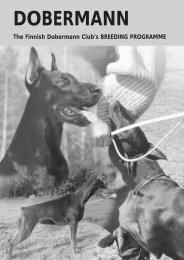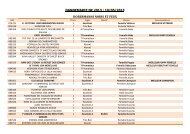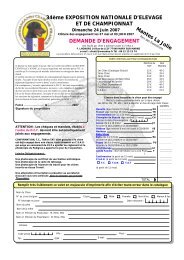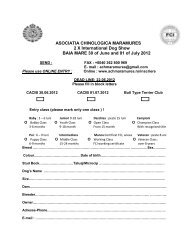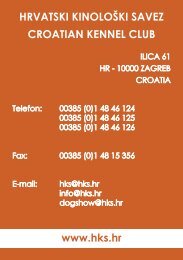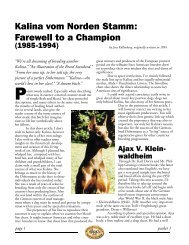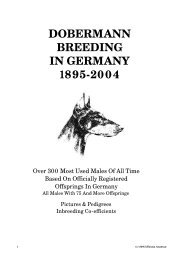Alida v.Flandrischen Loewen - Dobermann Review
Alida v.Flandrischen Loewen - Dobermann Review
Alida v.Flandrischen Loewen - Dobermann Review
- No tags were found...
You also want an ePaper? Increase the reach of your titles
YUMPU automatically turns print PDFs into web optimized ePapers that Google loves.
did come to an unorthodox arrangement whereby herowner would breed her to the male of Jens’ choice, and wewould buy all the bitches in the litter. It was Alexa’s owner’sfirst litter, the “A” litter, and there were five bitches inall: Anka, Anja, Amida, Azura, and <strong>Alida</strong>. We ran all thepuppies on till 3 months of age, and then made our finalpicks, retaining the two pearls (<strong>Alida</strong> and Anka). Azurawent to Australia and died of milk fever while raisingher second litter. Amida went to the German Chief ofJudges Ottmar Vogel, and was later repurchased by usand finally exported to Adlercrest Kennels in the USA,where she went on to form a smalldynasty of her own internationally.Anja was sold locally, was never bred,and remains today with her family inElmshorn, Germany.But without a doubt, <strong>Alida</strong>and Anka were the stars. Bothbitches placed at the top of themajor Sieger shows, easily earningtheir conformation and workingchampionships. Through the breedingbox, they repeatedly proved tobe bitches of great genetic powers.These bitches weren’t the only starsin the litter, as the males Atlas,Aristo (exp. Norway) and Arminalso proved to be above averageshow dogs and producers. I personallyknow of at least five championsin this litter.<strong>Alida</strong> was an extroverted andflashy puppy. From both her parentsshe inherited the good shoulderand upper arm and strong bone andsubstance so necessary in any broodbitch worth its salt. From her sire came the rich color,strong head and way above-average fighting spirit andprey drive. These points weren’t lacking in Alexa either,but specifically from her mother <strong>Alida</strong> inherited the longneck that seemed to go on forever and her wonderfuldryness and style. More compact and muscular overallthough, <strong>Alida</strong> was a fast, dynamic bitch to work andshow, easily earning her championship, SchH III andFH titles. She also became Bundessieger and DV Sieger(German Club Specialty Winner) shortly before beingexported to the USA.It is worth mentioning here that German <strong>Dobermann</strong>sare practically unique amongst the large workingbreeds in that they have as often as not succeeded incombining their show and working champions in oneand the same dog.When it came time to breed <strong>Alida</strong>, Jens Kollenburgfound a male whose own individual qualitieswould not only compliment hers, but bring fresh impetusto the offspring through his own outstanding inheritance.Our “K” litter vom Norden Stamm, <strong>Alida</strong>’s firstlitter by the Sieger dog, Ebo v.d. Groote Maat, SchH I,has gone down in the history books as one of the mostimportant litters bred in Germany in that decade. Therewere 11 puppies. Most were exported to other lands andfive became champions. Of these, without a doubt themost famous is Kalina v. Norden Stamm, SchH III,a bitch whose formidable qualities in both the workingand show arenas have earned her high praise fromhigh places in several languages.Kalina, together with her fullsister in blood, Mia v. NordenStamm, by Ebo out of <strong>Alida</strong>’ssister Anka, can take their placeamongst the most titled animalsin the history of the <strong>Dobermann</strong>breed, in fact.There were nine bitches in the“K” litter, and all were pre-sold tobreeders world-wide who wishedto capitalize on their geneticbackground. The two males inthis litter, Ken and Kandy, wentinto domestic “working dog”homes, whose owners unfortunatelyshowed no interestedtalent in promoting them at stud.Therefore, it has been throughits female, or “mother line,” thatthis family has continued itswidespread influence on breed<strong>Alida</strong> and daughter Kalina development. Only Kalina,Kastra, and Kassandra remainedin Germany, with the twoformer later proving to be the most prepotent in successfullyreproducing their inheritance. The sisters Kamilla,Karma, Kitopakita, Karamella, Katrina, and Kira wentfar abroad to Sweden, Norway, Japan, the USA andAustralia (later re-directed to the USA) respectively. Itwas consistently found that their greatest successes weremost pronounced when these bitches were bred to thehighest quality males who could also fundamentallysupport their blood. The long list of Champions, Siegers,and Specialty Winners that have emerged from suchcombinations also supports this conclusion.It was near Christmas when <strong>Alida</strong> whelped us herfirst litter, and around that time my husband was inNew York at a Westminster show, on the invitation ofAmerican breeder/judge Marilyn Meshirer, to speak ata judges training seminar held in conjunction with theshow. It was here that Jens first met Ray Carlisle, a past-President of the DPCA and to become <strong>Alida</strong>’s futurepage 3 packet 1


